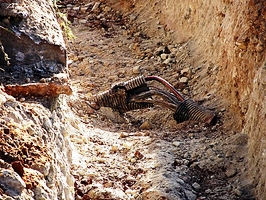What is Subsurface Utility Engineering? | What are SUE Quality Levels?
Subsurface Utility Engineering is a practice engaged during various planning and construction phases to identify underground infrastructure and conflicts. It involves utility locating, utility mapping and surveying.
What is Subsurface Utility Engineering?
 The SUE process or subsurface utility engineering is an engineering practice combining civil engineering, surveying, and geophysics, which utilizes utility locating techniques to provide critical and reliable data on the location of utilities in a specific project area. This utility engineering practice is engaged during various planning and construction phases which correspond with four Quality Levels.
The SUE process or subsurface utility engineering is an engineering practice combining civil engineering, surveying, and geophysics, which utilizes utility locating techniques to provide critical and reliable data on the location of utilities in a specific project area. This utility engineering practice is engaged during various planning and construction phases which correspond with four Quality Levels.
What are the SUE Quality Levels?
A. Designating & Locating
Quality Level A is the most precise quality level in the SUE Process. It is recommended during the design and construction phase of most projects. Here, exact horizontal and vertical locations of the facilities or utilities are determined and the utility is actually exposed through unobtrusive excavation methods, such as hydro excavation or potholing. The utilities are surveyed, measured, and utility mapping is executed.
B. Designating Only
Quality Level B is generally performed in the early design phase when utility records are unreliable. Here a utility locator determines subsurface data though geophysical locating methods, such as electromagnetic utility locating to identify the existence and approximate horizontal position of the utilities. The results are recorded onto a locating report.
C. Visible Features
Quality Level C is usually performed during the project-planning phases. Here, during a visual inspection of the site, utility locates data is estimated and plotted by correlating existing surveys (Quality Level D records) in combination with aboveground utilities. The assessments are then recorded.
D. Records Review
Quality Level D is generally performed during preliminary designs of a project to identify potential costly utility relocations. Here, there is no site inspection and subsurface utilities are estimated based upon existing records, and in some cases verbal recollections.
To learn more about subsurface utility locating, visit “What are the common utility location methods?”
Linc Energy Systems sells Pro-Line Tracer Wire.

